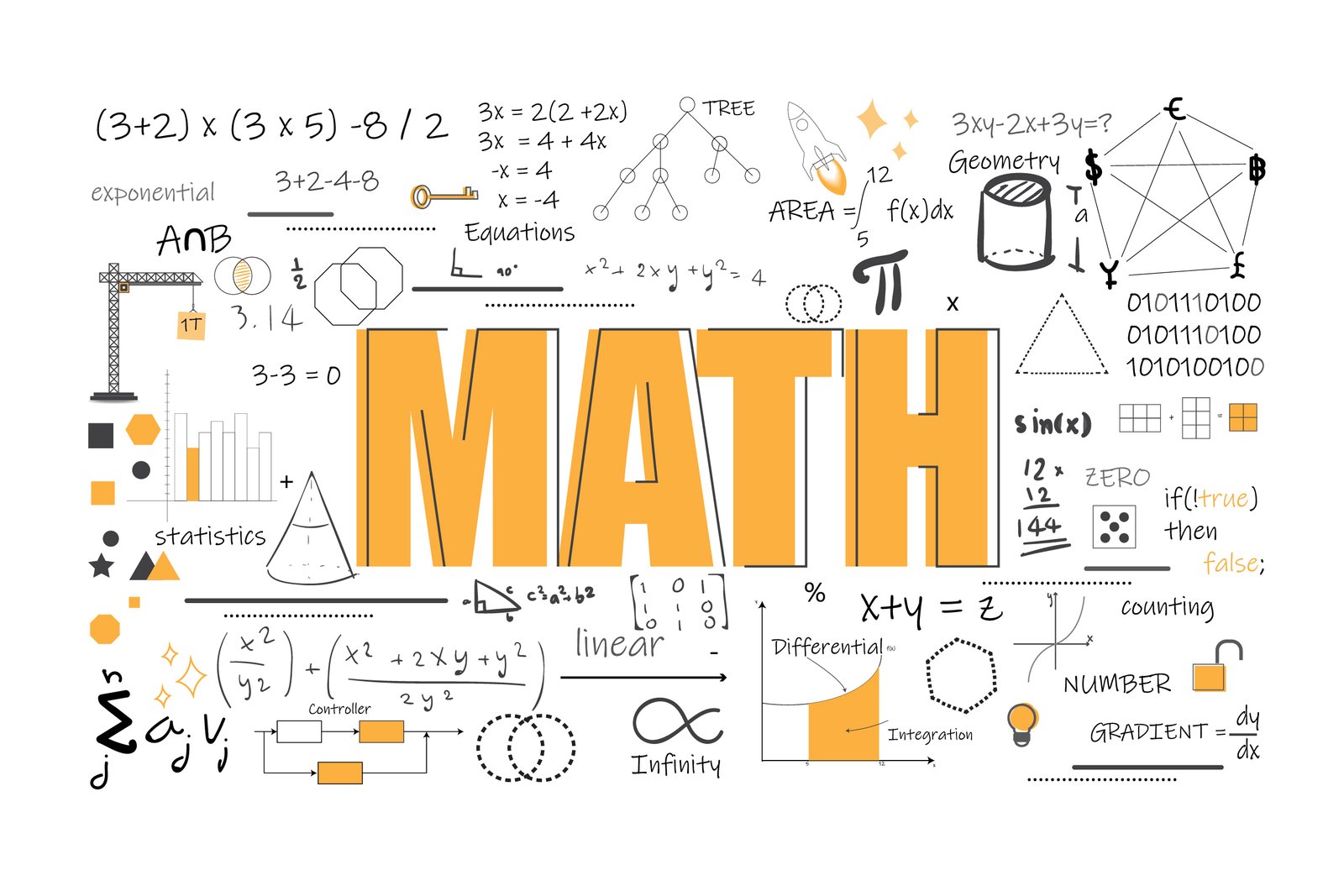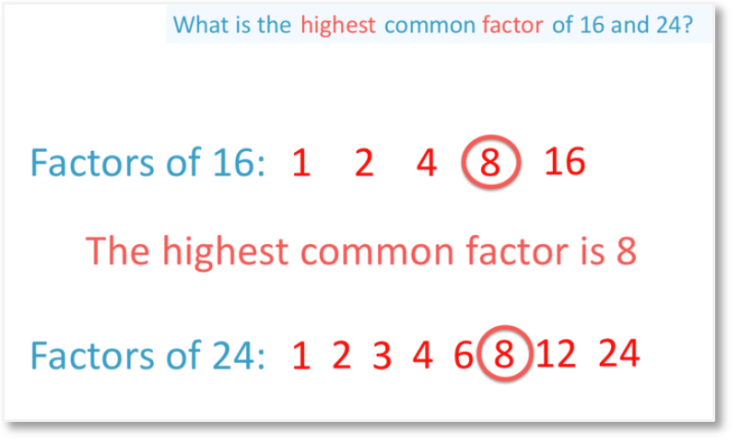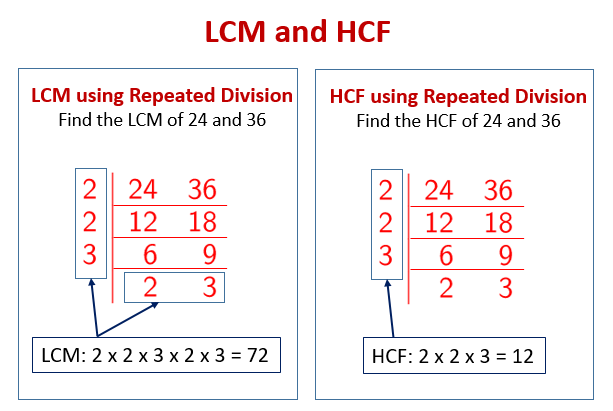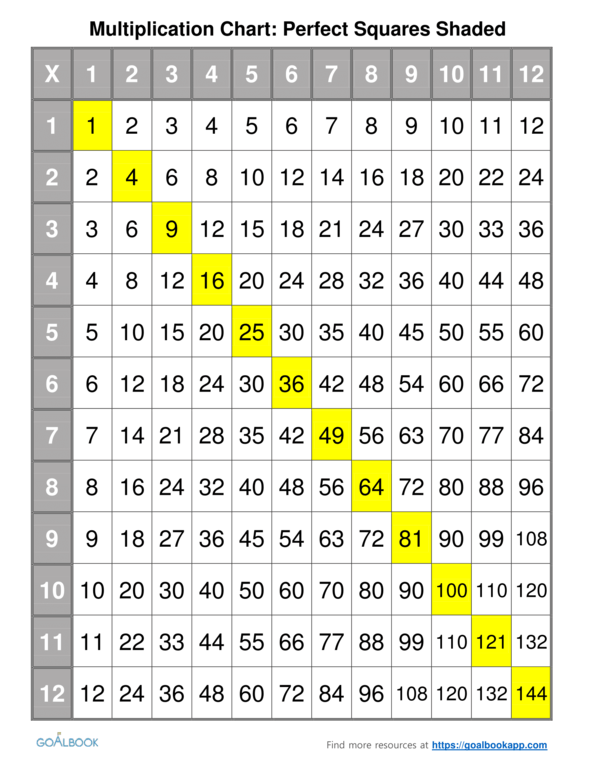Back to: MATHEMATICS JSS 2
Welcome to Class !!
We are eager to have you join us !!
In today’s Mathematics class, We will be discussing LCM, HCF and Perfect Squares. We hope you enjoy the class!

Highest Common Factors
A highest common factor is the greatest number which will divide exactly into two or more numbers. For example, 4 is the highest common factor (HCF) of 20 & 24.
i.e. 20 = 1, 2, (4), 5, 10, 20
24= 1, 2, 3, (4), 6, 8, 12, 24
Example:
Find the H.C.F of 24 & 78
Method 1
Express each number as a product of its prime factors
Workings
2 | 24 2 | 78
2 | 12 2 | 36
2 | 6 2 | 18
3 | 3 3 | 9
3 | 3
24=23x3
78 =(23 x 3) x 3
The H.C.F. is the product of the common prime factors.
HCF=23x3
=8×3=24
Method II
24=2x2x2x3
78=2x2x2x3x3
Common factor=2x2x2x3
HCF=24

LCM: Lowest Common Multiple
Multiples of 2 are =2,4,6,8,10,12,14,16,18,20,22,24…
Multiples of 5 are 5, 10, 15, 20, 25, 30, 35, 40
Notice that 10 is the lowest number which is a multiple of 2 & 5.10 is the lowest common multiple of 2& 5
Find the LCM of 20, 32, and 40
Method 1
Express each number as a product of its prime factors
20=22x5
32=25
40=22x2x5
The prime factors of 20, 32 and 40 are 2 & 5. The highest power of each prime factor must be in the LCM
These are25 and 5
Thus LCM =25 x5
=160
Method II
2 | 20 32 40
2 | 10 16 20
2 | 5 8 10
4 | 5 4 5
5 | 5 1 5
1 | 1 1
LCM =2 x 2 x 2 x 4 x 5 = 160

Classwork
Find the HCF of:
(1) 28 and 42
(2) 504 and 588
(3) Find the LCM of 84 & 210
READING ASSIGNMENT
New General Mathematics, UBE Edition, chapter 1, pages 20-21
Essential Mathematics by A J S Oluwasanmi, Chapter 1, Pages 1-4
PERFECT SQUARES
A perfect square is a whole number whose square root is also a whole number .It is always possible to express a perfect square in factors with even indices.
9 = 3×3
25= 5×5
225 = 15×15
= 3x5x3x5
= 32 x 52
9216 =96 2
=32 x 32 2
=32 x 42 X 82
=32x24 x26
=32 x2 10
Workings
2 | 9216
2 | 4608
2 | 2304
2 | 1152
2 | 576
2 | 288
2 | 144
2 | 72
2 | 36
2 | 18
3 | 9
3 | 3
9216= 32x210

Example
Find the smallest number by which the following must be multiplied so that their products are perfect square
- 540
- 252
Solution
2 | 540
2 | 270
3 | 135
3 | 45
3 | 15 54=22 x 33x 5
5 | 5
1 |
The index of 2 even. The index of 3 and 5 are odd. One more 3 and one more 5 will make all the indices even. The product will then be a perfect square. The number required is 3×5 =15
(2)
2 | 252
2 | 126
3 | 63
3 | 21
7 | 7
1 |
252= 22x32x7
Index of 7 is odd, one more “7” will make it even.
Indices i.e. 22x 32x 72
Therefore 7 is the smallest numbers required
READING ASSIGNMENT
New General Mathematics, UBE Edition, chapter 1, pages 20-21
Essential Mathematics by A J S Oluwasanmi, Chapter 1, pages 1-4
WEEKEND ASSIGNMENT
- The lowest common multiple of 4, 6 and 8 is (a) 24 (b) 48 (c) 12 (d) 40
- Find the smallest number by which 72 must be multiplied so that its products will give a perfect square (a) 3 (b) 2 (c) 1 (d) 5
- The lowest common multiple of 4, 6 and 8 is (a) 24 (b) 48 (c) 12 (d) 40
- The H.C.F. of 8, 24 and 36 is ___ (a) 6 (b) 4 (c) 18 (d) 20
- The L.C.M. of 12, 16 and 24 is ___ (a) 96 (b) 48 (c) 108 (d) 24
THEORY
- Find the smallest number by which 162 must be multiplied so that its product will give a perfect square.
- Find the HCF and L.C.M. of the following figures
- 30 & 42
- 64 & 210
We have come to the end of this class. We do hope you enjoyed the class?
Should you have any further question, feel free to ask in the comment section below and trust us to respond as soon as possible.
In our next class, we will be talking about Fractions as Ratios, Decimals and Percentages. We are very much eager to meet you there.

very interesting
I love your class but what about indices am finding it difficult to understand pls give a brief explanation thank you.
Glad you found it helpful😊 For even more class notes, engaging videos, and homework assistance, just download our Mobile App at https://play.google.com/store/apps/details?id=com.afrilearn. It’s packed with resources to help you succeed🌟
For the first class work for this week
28=2*2*7=28
42=3*2*7=42
=2*7=14.
2.)504 & 588
504=2*2*2*3*3*7=504
588=2*3*7*7
=2*3*7=42.
3) Lcm of 84 & 210
84=2*3*3*7
210=2*3*5*7
2*3*7=42
Please give this to all students from JSS 1 to SSS 3